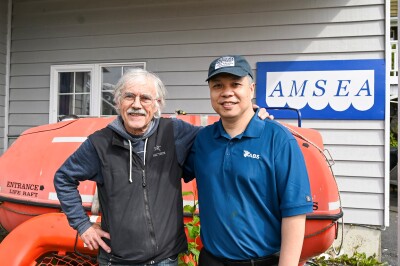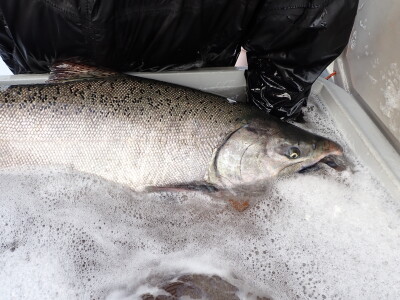Alaska & Pacific King Crab
Influx of unregulated Russian product undercuts Alaska's Bering Sea harvest
When Alaska king crabbers splashed their pots last year, they began fishing on the 2012-13 season's total allowable catch of 7.85 million pounds, which was slightly higher than the 2011-12 TAC of 7.83 million pounds.
But ex-vessel prices from one season to the next weren't even close, falling from $10 per pound in 2011-12 to $7.25 as the 2012-13 season began. Industry observers blame an influx of illegally harvested Russian crab going into markets in Japan — where more than half of Alaska's king crab winds up.
Illegal, unregulated and unreported crab harvests are nothing new, they say. But the recent supply surge has dampened ex-vessel offerings.
"The markets have been declining for most of the year because of illegal crab," says Jake Jacobsen, executive director of the Inter-Cooperative Exchange, a Seattle-based crab harvester group.
According to preliminary estimates from the McDowell Group, in Juneau, Alaska, illegal Russian crab volumes jumped 36 percent from 2011 to 2012, putting more than 123.1 million pounds into world markets. Of that amount, 65.9 million pounds were king crab versus 35.3 million in 2011.
"This has definitely had an impact on the market," says Andy Wink, a McDowell Group seafood analyst, noting king crab prices have declined since 2011. "They were down over $3, in ex-vessel terms, for red king crab. With a 7 [million] to 8 million pound TAC, that's a lot of money." According to McDowell Group data, it adds up to $13.3 million lost.
"I think a lot of this increase in IUU supply went into Japan in 2012," Wink says, "but it's almost a given that some illegal crab comes into the United States, too."
The United States and Russia have begun discussions on tightening up previous treaties that aimed to stymie IUU harvests. It's hoped those discussions will find a way to crack down on the latest influx of IUU crab.
"We're hoping that it will slow down, if not put a stop to, the illegal crab," Jacobsen says.
The two nations have worked together since 2008 to curtail the IUU harvests, which had been declining through 2011 before rising again in 2012; it's unclear what caused the increase. However, Jacobsen notes, "there will always be corrupt individuals" who can derail treaty efforts.
Meanwhile, speculation abounds that ex-vessel prices could rebound if intensified efforts to curb IUU harvests prevail. Jacobsen says that if those IUU volumes disappeared, demand for Alaska's 7.8 million pounds would soar.
Surveys conducted in August will help determine the 2013-14 TAC. The earliest look at recommendations was to be made public in mid-September, says Heather Fitch, Bering Sea-Aleutian Islands area management biologist with the Alaska Department of Fish and Game.
Last year, the industry feared the TAC would be lower than the 2011-12 cap of 7.8 million pounds, but bigger crab convinced managers to keep it the same.
"The biomass did go down a little bit from 2011-12," Fitch says. "But the average size in the 2012 survey was larger; so that's why the TAC was similar."
The industry's evolution from an open access fishery to an IFQ regime continues. One development is the inception of a program being funneled through the Inter-Cooperative Exchange that would give deckhands first rights of refusal when IFQ shares come up for sale.
Jacobsen says about a dozen crew members had signed up through July and he expects more will as the program gains publicity.
"In the old days you start on deck with a share of the catch and work your way up until you were running the boat and eventually own it," he says.
"Nowadays, you can't buy a boat and go fishing. You have to buy quota shares." — Charlie Ess
Poaching, pent-up demand, parched waterways put pressure on producers
Atlantic Oysters
Scarce fresh water in the Southeast, Hurricane Sandy's lingering effects, and even oyster rustlers on Cape Cod complicated the oyster business as a recovering economy slowly steps up shellfish demand.
Modest-sized oysters sold for around $40 per bushel dockside in Virginia in early summer. As August began, the benchmark retail menu at New York City's Grand Central Oyster Bar was listing Massachusetts Wellfleets and Cotuits for $2.65 apiece, and some Canadian oysters were topping $3.
That spurred poachers to loot Wellfleet growers' plots repeatedly, raising suspicions that some dealer was laundering stolen shellfish.
Nationally supplies will tighten, given escalating problems in Florida, which supplies 8 percent of the nation's oysters. Some 92 percent of Florida's landings have historically come from Apalachicola Bay, where recruitment crashed in 2012, and oyster tongers are working harder for smaller catches.
An April 2013 Florida Sea Grant report warned full recovery could take three to five years. With oystermen's support, the Florida Fish and Wildlife Conservation Commission shortened the summer season workweek from seven to five days, and commission law enforcement officers made more than a dozen arrests for illegal oystering.
Commerce Secretary Penny Pritzker issued a disaster declaration for the 2012 fishery in August. Biologists blame the decline on a number of factors, including weather and high salinity levels. NOAA says those factors caused a 60 percent drop in West Coast landings.
"It is evident from divers' observations that many reefs in Apalachicola Bay are showing the negative effects of decreased rainfall and freshwater flow rates from the Apalachicola River over the past two years, including depressed recruitment and increased oyster mortality," the Florida Division of Aquaculture reported in 2012.
This year those problems have continued and part of the blame is falling on lower levels of fresh water coming to the Apalachicola basin. Florida Gov. Rick Scott announced on Aug. 13 that the state will file suit with the U.S. Supreme Court to halt what was termed "Georgia's unchecked and growing consumption of water, which is threatening the economic future of Apalachicola."
Virginia continued to grow its way back toward becoming a producer again, with a $2 million project to restore historic oyster grounds with fossil shell mined from the James River. The 2012 harvest of 250,000 bushels worth $8 million seems modest compared to, say, Louisiana's $41 million harvest in 2011. Still, it was Virginia's best season in more than 20 years.
But Virginia also had its first run-in with Vibrio parahaemolyticus, a warm-water bacterium that scientists say is a greater problem with a warming Mid-Atlantic climate. In July, Virginia closed private oyster beds near Fisherman Island on the Eastern Shore after three reported cases of illnesses. The bacteria, though not life-threatening, can cause acute gastrointestinal illness.
Hurricane Sandy slammed New Jersey's small but promising coastal oyster culture industry. It caused a five-month shutdown as the industry and regulators debated the accuracy of new testing methods for bacteria and viruses.
The Barnegat Bay volunteer shellfish restoration group ReClam the Bay got a surprise donation from Belfast, Maine, artist Jerri Finch Holmes, who spent childhood summers at the Jersey Shore and still has family there. She raised $1,700 with a community raffle for her paintings in her hometown.
The group is using part of that money to grow young oysters and clams in onshore upweller tanks. They'll be donated to help Barnegat Bay growers get back up to speed. — Kirk Moore






